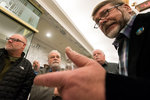



OLYMPIA — As the Washington Department of Fish and Wildlife continues studying hoof disease in Washington elk populations, there’s an effort to give the public a leadership role in collecting input and setting direction for the future.
Some citizens involved with WDFW work groups want more say and more transparency, and that’s what they hope to achieve with a proposed bill in the state Legislature requiring a citizen to chair the groups.
It would apply to everything from wolf management and salmon fishing to the ongoing pursuit of answers on hoof disease.
House Bill 2446 is sponsored by 19th District Rep. JD Rossetti, D-Longview, Rep. Brian Blake, D-Aberdeen, and 20th District Rep. Ed Orcutt, R-Kalama.
It requires a citizen not employed by the government to lead the work groups.
The Agriculture & Natural Resources Committee, chaired by Blake, held a public hearing on the bill Wednesday in Olympia.
Rossetti, the primary sponsor, said citizen participation is a serious concern and that increasing the public’s role is important.
“The people is who is important, and it’s the people’s voice and their participation that’s the emphasis of this bill,” he told the committee.
Mark Smith serves on the Elk Hoof Disease Public Working Group and testified in favor of the legislation. WDFW Region Manager Sandra Jonker is the current chair of the group, which also includes staff from the agency and concerned residents.
Smith said staff sets the agenda and topics for discussion for a possible predicted outcome, and by having government employees chair the committees, true public influence isn’t allowed.
“Placing the management of these groups through the citizen’s chair would help provide greater transparency and allow for more open insight into the review process and help eliminate the idea of WDFW having a preconceived solution before establishing the groups,” Smith said.
He said the workgroups should be run by citizens and supported by Fish and Wildlife staff.
Smith said committee members have asked for Fish and Wildlife to take a more proactive approach to finding a solution to hoof rot in elk, which has been found in the state since the 1990s.
Smith, the owner of the Eco Park Resort, located off of state Route 504, also known as Spirit Lake Highway, referred to himself, and other citizens knowledgeable about hoof rot, as the “boots on the ground.”
He told The Chronicle that Fish and Wildlife officials should utilize them.
“I live in the woods,” he told The Chronicle, questioning how much time Fish and Wildlife employees spend out of the office.
“They really need these groups to understand,” he said.
Bruce Barnes, a hunter from Vancouver, Wash., said the groups don’t have action plans. He said it seems like more money is spent on studies than resolving issues.
“I think with the public there would be a plan of action and ultimately a solution to what’s going on,” Barnes said.
Phil Hall, a lifelong hunter and fisher in the Mount St. Helens area, said if passed, the bill would create better understanding and cooperation between citizens and Fish and Wildlife.
Carl Burke, representing Fish Northwest, Puget Sound Anglers and the Northwest Sportfishing Industry Association, was the only person to testify the against the bill at the public hearing.
Burke said he has been appointed to multiple workgroups and advisory boards and said they are used to determine how to allocate natural resources between the different fishing industries.
The outcomes of the meetings are often contentious, he said, and giving a citizen control over the agenda and outcome of meetings would escalate conflicts.
He said agency oversight is necessary to ensure no acts or policies are being violated by the groups or their decisions.
Some of the support from the bill emanates from a belief that WDFW has not pursued all the potential causes and treatments for hoof disease, choosing to manage it rather than attempt to eradicate it.
The strain of hoof disease, known as treponeme-associated hoof disease, or “TAHD” in WDFW parlance, has been a common affliction of domestic barnyard animals for decades, but up until 2014, it had never been officially documented in wild animals.
The Washington Department of Fish and Wildlife implemented a survey between March and May 2015 using more than 200 trained volunteers, who drove 7,300 miles through 10 counties to monitor elk groups. Wildlife biologists also participated in some locations difficult for volunteers to reach.
It was found that about 48 percent of regional elk herds had at least one limping elk that appeared to be suffering from the disease.
Recent efforts to contain the disease include a new WDFW hunting regulation that requires a hunter to sever the lower leg portions of all harvested elk and leave them at the kill site with the rest of the carrion. That requirement was put in place prior to the 2014 elk hunting season. In a press release from that same year, Nate Pamplin, director of the WDFW Wildlife Program, direly noted what is still a reality when he said, “At this point, we don’t know whether we can contain this disease.”
Hoof disease can cause lesions, sores and mangled deformities of the hoof that severely limit an animal’s ability to forage, find shelter, evade predators or keep up with their herd. Many victims wind up starving to death due to their inability to walk or even stand. The WDFW is currently in the midst of two separate studies on hoof disease in elk. One of those studies is to assess the prevalence of TAHD in Southwest Washington elk and the other study is examining the impact of the disease on elk survival and reproduction.
•••
Outdoors Reporter Jordan Nailon contributed to this report, which also includes information from The Chronicle’s archives.